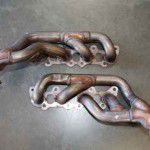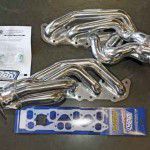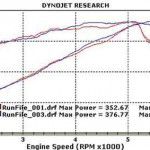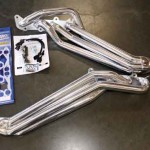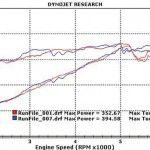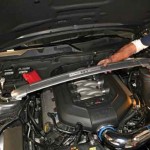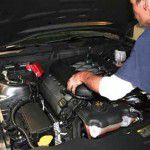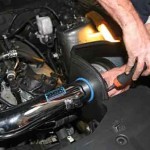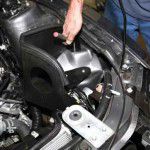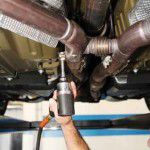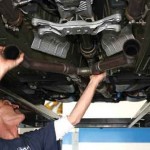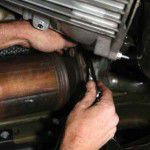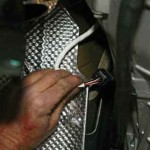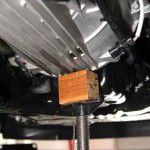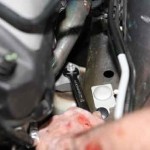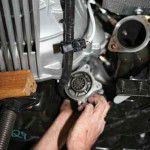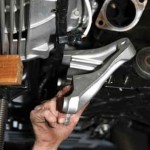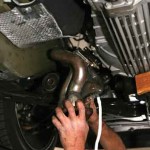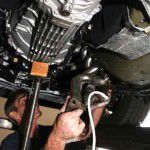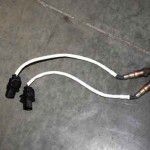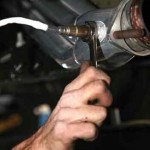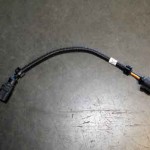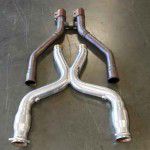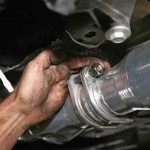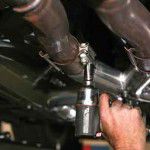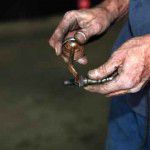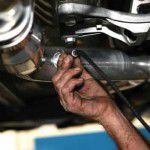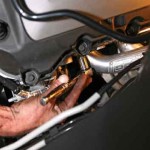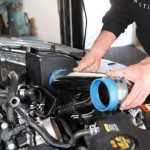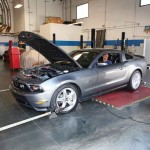The BBK Header Challenge – Stock vs. Mid-Length vs. Long Tube
Text and Photos by Courtney Halowell
Article
We’ve actually wanted to do this for a long time, but when it came time to swap, we realized that we’d have torun our car with stock exhaust manifolds on the dyno, and then take the time to swap them out for mid-length headers, run it again, and then swap the whole mess out for a set of long tube headers before running it on the dyno one more time. That could take days!Thankfully, that’s where our buddy Mike from the R&D department at BBK Performance entered the picture. There was an ‘11 Mustang with a 5.0 engine in BBK’s R&D fleet, and at the time we spoke to him it had stock exhaust headers on it.
Mike agreed to run it on the dyno with the stock exhaust (the car was fit with a BBK cold air intake and throttle body) and then swap them out for a set of BBK-tuned mid-length headers and run it on the dyno again. While we were there, he would take the mid-length headers off and swap them out with the long-tube headers and one of BBK’s X-pipes with built-in catalytic converters and run that setup on the dyno. (Sorry, the X-pipe isn’t legal for street use in California, but the other 49 states are fine.)
The stock manifolds were the most restrictive—no surprise there—and the mid-length made just shy of 25 more hp and the most torque of the bunch; while the long tube headers made 42 hp over the stock manifolds with about 1 1/2 fewer lb-ft of torque than the mid-length headers. But you can read all about it and see the dyno charts in the captions.
Follow along as Mike from BBK swaps out the company’s mid-length headers for a set of long tube headers for no other reason than to educate our beloved readers and to satisfy our curiosity about how the length of headers can affect performance.
SOURCE
BBK Performance
27440 Bostik Court
Temecula, CA 92590
951.296.1771
Gallery
- After a test drive to make sure everything is tight, Mike straps the ‘11 Mustang down on the dyno and prepares to make one final pull. Of course we cheated and showed you all of the dyno runs right up front.
- These are the stock exhaust manifolds for the ‘11 Ford Mustang with the 5.0 V-8 engine. You can see how the front and back two exhaust ports both dump into a single tube and then into the two-into-one collector. On the BBK dyno the peak hpthey made on the car was 352.67, with a peak of 361.94 lbs-ft of torque.
- Here are the BBK mid-length headers, and it is pretty easy to see where each individual exhaust port has its own tube that runs all the way into the four-into-one collector. The mid-length headers are California-legal because they retain the stock cats and H-pipe. You can see on the dyno chart that the mid-length headers make almost 25 more peak hp than the stock manifolds. On the torque side, the peak numbers only show a gain of a few lbs-ft, but where the stock manifolds see a significant dip between 3,800 to just over 4,800 rpm, the BBK headers actually have a pretty smooth power curve.
- These are the BBK full-length headers and the corresponding dyno chart that compares them to the stock manifolds. While the torque gains are pretty insignificant, the peak hp numbers are impressive. The long-tube headers in conjunction with the BBK X-pipe see a peak hp gain at the top end of 394.58. That is a 41.91-hp gain through the factory mufflers!
- To get started, the battery is disconnected, the strut tower brace and the plastic engine cover are removed.
- The BBK cold air intake has to be removed as well to make room to get to the driver’s side header bolts.
- Followed by the cross-brace that ties the frame together just behind the lower control arms.
- Next, the stock cats are unbolted from the collectors and the oxygen sensors are unplugged.
- In order to get clearance to remove the driver’s side manifold or header, the steering shaft must be disconnected at the rack side.
- A transmission jack is used to support the engine and transmission so that both of the cast aluminum engine mounts can be removed.
- Both of the bolts that hold the mounts to the subframe of the car are removed from the top, and then the four bolts that hold the driver’s side mount to the engine are removed.The entire mount can be fished out of the left side.
- The passenger side is a little trickier.The starter has to be removed so that the engine mount can be removed.
- It’s back up top to take out the header bolts.
- With all of the bolts that hold the header flanges to the block removed, the mid-length headers come right out underneath the car.
- With the mid-length headers out of the way, the new gaskets and full-length headers can be installed.
- All of the items that had to be disconnected or removed,like the steering shaft, engine mounts, cross-brace and starter,can be reinstalled.
- The oxygen sensors that came out of the stock manifolds/BBK mid-length headers are installed in the collectors of the full-length headers with a dab of anti-seize.
- In most cases the wiring on the stock oxygen sensors won’t reach where they need to in order to plug into the harness, so BBK includes these extensions with its long-tube headers.
- The BBK full-length headers require the addition of its X-pipe (front)with the cats built-in and use a true “X†design instead of the stock, restrictive H-type crossover tube (rear).
- The new X-pipe is bolted into place at the collectors up front and at the rear pipes just in front of the stock muffler.
- Another dab of anti-seize and the oxygen sensors that go in the X-pipe behind the cats are installed.
- Back up top, all of the header bolts are snugged.
- Items like the cold air intake and the engine cover are reinstalled and the battery is reconnected.


